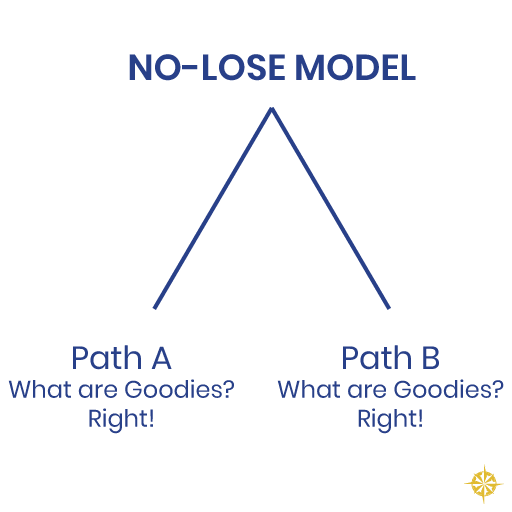I wanted to follow up Susan Jeffers Pollyanna theory with a real gem: How to Make a No-Lose Decision.
Think about that title: How to Make a No-Lose Decision…
How can someone make a decision that has a no-lose clause?
It doesn’t seem logical or realistic does it?
But when I read her process, I realized that wow, you really can create a no-lose decision. How? Let me show you:
In chapter 7 of her book, Jeffers talks about the No-Lose Model. In this model she brings the reader to the point of decision making – the Choice Point. Using her example, the decision maker can either stay in the job they are in or take another job that is being offered.
Now, before we discover the brilliance of the No-Lose Model, let’s take a look at the No-Win Model – the old way of thinking.
In this model, Jeffers takes the reader through the same scenario bringing them to the Choice Point. What she wants us to see is that when we are faced with decisions, we typically look at both the positive and the negative consequences of our potential choices. Let me show you her diagram and maybe that will help:

What happens to us when we face a decision and try to think of all the possibilities, positive and negative, Jeffers argues that we tend to end up right where we were in the beginning – unsure. Her point is that we cannot confirm the reality of any of those possibilities and so thus we are in a continuous cycle of insecurity and indecision.
She then proceeds to point out, if we stop looking at what could potentially go wrong and look only at what could go right, the decision is a win/win and never a lose/lose outcome.
In her No-Lose Model, the process eliminates the potential for conflict by only focusing on what the two options positively offer. Here is that diagram:

The “Goodies” in her No-Lose Model speak to the pluses of each opportunity, the sweets and treats! What does each bring to the table? What will I gain from the experience that I didn’t have before? What are the potential growth opportunities? What pluses does each provide me? Jeffers argues that when you put the positive on the focus you eliminate the conflicting and unconfirmed potential negatives to the choices.
But isn’t that a bit Pollyanna-ish, Kendel?
Well, at first, that appears true. However, what Jeffers is saying here is that staying or going really isn’t the issue. What is at issue is what are YOU going to make out of each opportunity to gain the most from the experience. Whether it is the right choice or not doesn’t mean it is going to be a ‘bad’ choice because even in a ‘bad’ choice you learn about yourself, your skills, and your desired quality of life.
Where I would elaborate on Jeffers work is that staying in the No-Win Model has more to do with fear then to do with goals. We tend to stay in the dilemma of indecision not so much for failure to see the possibilities but fear of change. Just because we desire more doesn’t mean we want to risk to get more – there are a lot of examples of risking and failing to confirm our biases. Instead of venturing beyond our discomfort and misery, many stay because at least we know that we can’t be more miserable!
The words ‘what if…’ or ‘yeah, but…’ are our internal ‘safety alarm’ going off.
Where Jeffers work is so powerful is she moves us beyond the ‘safety alarm’ and into a new mindset of endless possibilities of success.
I’ve really enjoyed Jeffers work and I hope this small article helps you see how to improve your mindset for success.
If you’d like to work on your mind-set towards success and achieve your desired goals in life but are struggling to move past those nasty ‘safety alarms’ going off in your head, get in contact with me through either the Contact form or Schedule a Call on this webpage and let’s get you moving forward!
